

Evan's Regents Chemistry Corner. Unit 2 - Atom and Bonding - JOE'S CHEMISTRY WEBPAGE. District 833 Moodle: Log in to the site. Ms. Ciccone's Science Room. Unit 6 - Gas Laws - JOE'S CHEMISTRY WEBPAGE. WELCOME TO MR. CORLETO'S FLIPPED CHEMISTRY CLASSROOM - Home. EricksonCPChem2010-11 - Pages and Files. Mr.T's Chemisty 11. Stoichiometry Guided Instructional Activities with Guide Framework. Guided Instructional Activities (GIAs) were part of the “Mastering Chemistry on the Web” (MCWeb) program, a part of the National Science Foundation Molecular Science Project ( (link is external)).
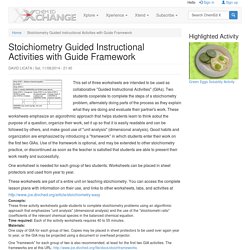
Dr. Patrick Wegner (California State University, Fullerton) developed these POGIL-like (Process-Orineted Guided-Inquiry Learning) activities for use in preparatory and general chemistry classes. While some of the activities are, like POGIL real guided inquiry, many are simply cooperative learning activities that give students an opportunity to work toward a common goal while discussing and practicing skills of particular interest. The usual procedure is to assign students randomly into groups of two (which change for each activity). They work at tables of two groups each. These GIAs are part of a unit on stoichiometry. Chemical Education Xchange. Most students, and many of my (now former) colleagues, find stoichiometry to be one of the most challenging topics in a first year (and yes, even a second year) chemistry class.
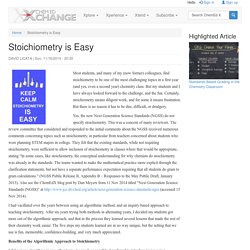
But my students and I have always looked forward to the challenge, and the fun. Certainly, stoichiometry means diligent work, and for some it means frustration. But there is no reason it has to be dire, difficult, or drudgery. Yes, the new Next Generation Science Standards (NGSS) do not specify stoichiometry. This was a concern of many reviewers. Mrs. Morrison's "Flipped" Science Class - Home. Unit 6: Ionic Bonding - Mrs. Curtin Chemistry. Chemical Education Xchange. R Unit 6 Heat - Ms. Drury's Flipped Chemistry Classes.
Mr. Palermo's Flipped Chemistry Classroom - www.mrpalermo.com. Mr. Baker’s BCA Home Page. Default. Skip to Main Content District Home Sign In.
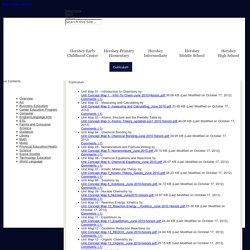
Mr. Christopherson / Stoichiometry. Skip to Main Content District Home Select a School...
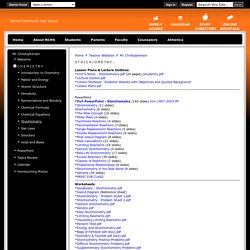
Select a School Sign In Register. Teacherknowledge - Resources for Teaching Chemistry. What's New at Science Notes - Science Notes and Projects. Chemistry Calendar. Chemical Education Xchange. Stoichiometry Fireworks Lab Quiz. Honors Chapter 11. Teaching High School Chemistry - Blog. ScienceFix - Science Fix. State testing is late in the school year which means that we get to spend only about two to three days on our last unit, astronomy.
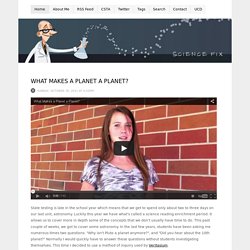
Luckily this year we have what's called a science reading enrichment period. It allows us to cover more in depth some of the concepts that we don't usually have time to do. This past couple of weeks, we got to cover some astronomy. In the last few years, students have been asking me numerous times two questions: "Why isn't Pluto a planet anymore?
", and "Did you hear about the 10th planet? " Derek Muller, the main host of the videos, usually goes to the streets and asks questions to ordinary people about a particular science concept. I decided to ask the question, "what makes a planet a planet? " Whitney High School - Chemistry. Itled. This web site ( uses browser detection to determine the browser type and browser version of site visitors.
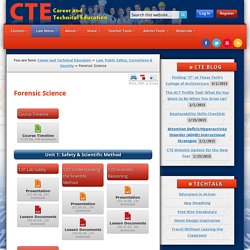
This information is used only in its aggregate form, to help us further refine our web site design. The remote host name is collected from each site visitor, and is used only to provide statistical data, specifically, the percentage of "hits" from the UNT domain vs. the percentage of "hits" from outside the UNT domain for this web site.
The pages accessed by each visitor are recorded and preserved in an aggregate form to provide us with information about the relative usage of the pages in our web site. This also aids us in the generation of state-required usage reports. The web page that referred the site visitor to this UNT-hosted web site is also recorded, and used to improve overall site navigation where possible. Making Measurement Meaningful or Why to Avoid Saying "Sig Figs" in Class. Every year when the day came to discuss the rules for significant figures in measurements with my classes I would write the rules on the board, we’d work through a couple examples, and I’d try to find a way to explain why we needed to use them when reporting measurements.
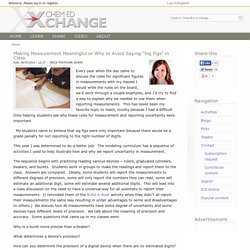
This has never been my favorite topic to teach, mostly because I had a difficult time helping students see why these rules for measurement and reporting uncertainty were important. My students came to believe that sig figs were only important because there would be a grade penalty for not reporting to the right number of digits. This year I was determined to do a better job. The modeling curriculum has a sequence of activities I used to help illustrate how and why we report uncertainty in measurement. The sequence begins with practicing reading various devices – rulers, graduated cylinders, beakers, and burets. Why is a buret more precise than a beaker? What determines a device’s precision? JCE Chemical Education Xchange. Classwork and Homework Handouts. Index of /Chemistry/chempdfs. Chemdemos. CanScience - Fall 2014 Binder Table of Contents. Daigneault (vachon) chemistry - Home. Slhsacademicchemistry / 5- Nomenclature. Mrs. Giammanco's Chem 1 Home Page.
Lydia Berry at Martin High School. First Five. First Five for November 10 & 12 A particular atom has eight protons, eight electrons and ten neutrons.
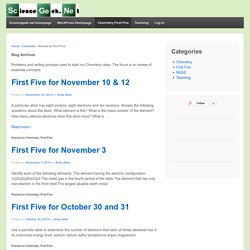
Answer the following questions about this atom: What element is this? What is the mass number of the element? Lesson: Nat. of Sci. mini-lesson: Checks Lab. Before Doing this lab, consider doing the NEW High-Tech Version: The E-Mail Lab.
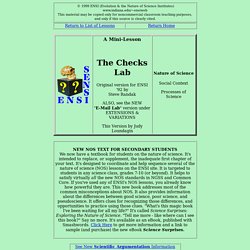
(Details below under EXTENSIONS AND VARIATIONS. TEACHER PREPARATIONS: 1. PB193X2web.pdf. Chemistry Resources Resource listing. Chemistry-misconceptions.pdf. Quiz: The History of the Periodic Table. Mrs. Falk's Chemistry Page - Regents Chemistry. Atoms from A to easy! Gablescience - Unit 1 Honors. OnLine Packets. Honors Chemistry:(click here for honors chem) Concepts of Chemistry:(click here for concepts of chem) Chemistry: Semester 1 [ pack1 ] [ pack2 ] [ pack3 ] [ pack4 ] [ pack5 ]

All Chemistry - Honors Unit 1 - Matter and Measurement. Notes and Handouts - Mr. Hoffman's Chemistry World. Timothy Berning » Honors Chemistry.
Wpschemistry - Chapter 12 Bell Ringers. Home - Meeks Science Webpage. Build an Atom 1.1.2. Junior Chemistry with Chemguy. Mary Elizabeth Chemistry. Problem-Based Learning at University of Delaware. Class_calendar. General Chemistry. Chempodcasts.com. The ChemCollective: Find Activities. The ChemCollective is a collection of virtual labs, scenario-based learning activities, tutorials, and concept tests.
Teachers can use our content for pre-labs, for alternatives to textbook homework, and for in-class activities for individuals or teams. Students can review and learn chemistry concepts using our virtual labs, simulations, and tutorials. The ChemCollective is organized by a group of faculty and staff at Carnegie Mellon who are interested in using, assessing, and creating engaging online activities for chemistry education.
In the game Mixed Reception, students use molar mass calculations, the scientific method, and basic knowledge of chemical reactions to solve a murder mystery. Students interview suspects and gather evidence as they solve the case. Mr. Kent's Chemistry Regents Help and AP Chemistry Exam Review Pages. Virtual Chemistry Experiments. Teach21 Project Based Learning. CASES Online: Creating Active Student Engagement in the Sciences. CSIP Student Inquiry Projects - Tamara Hanna's CSIP Project. Detection of Ions in Solutions Using Acid/Base Chemistry: A Quality Control Test Tamara Hanna 2004-2005 CSIP Fellow This curriculum unit allows students to become quality control testers and determine the amount of Ca2+ in Tang® and Mg(OH)2 in milk of magnesia through the use of acid/base titrations.
Students will standardize three solutions that will be used in detecting the ions and will learn about titrations, indicators, pH and pH meters and the preparation of solutions, all included in a Regents curriculum. These experiments were designed for use by high school chemistry classes, either Regents or AP. This curriculum gives students a chance to see how solutions are analyzed in a chemical setting.
The unit was developed/modified by Tamara Hanna, a graduate student in chemistry at Cornell University and was adapted from a lab written by Dr. LEARN NC: Search Results. Alternative energy: Where's the chemistry? In Why does chemistry matter in my life? , page 8. Web-based Inquiry Science Environment (WISE)
Nuclear Chemistry. Problem-Attic. Tyler DeWitt. Collections. Free Chemistry Video Lecture courses. Target Inquiry. Resource Library - Gooru. AP Chemistry. Misterguch.brinkster.net/2009homework.html. My 2008-09 Chemistry Homework Assignments! Because I know it’s sometimes handy for new (and not so new) chemistry teachers to see what other teachers are doing, I’ve decided to post, in chronological order, links to each of the homework assignments I gave my chemistry classes in the 2008-09 school year. As you can tell, I like to write my own questions as opposed to using the textbook. A couple of warnings: Because I use these worksheets myself and my students are very aware of my website, I have not included the answer keys to any of these worksheets.
I also can’t promise that they’re perfect in every way – some may have errors that I haven’t fixed yet. Another thing to keep in mind: If you don’t see a topic, homework was probably in some form other than worksheets. You’ll need the Adobe Acrobat Reader to access these files. 9/5: Safety and equipment homework sheet, safety contract 9/9: Scientific method worksheet. 9/11: SI units homework 9/17: Data Collection Review Sheet. Off the Shelf Chemistry. 1. The student will learn that chemicals are not something just found in laboratories. Our physical environment is composed of chemicals. Our bodies are composed of chemicals. Understanding the principles of chemistry helps us better understand our world.